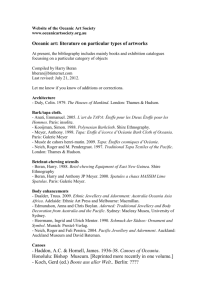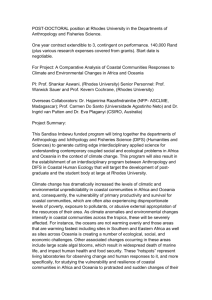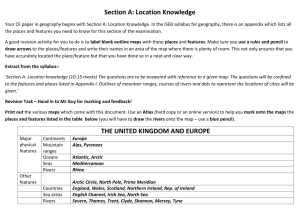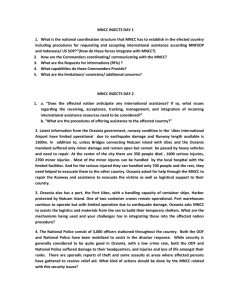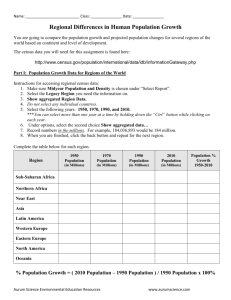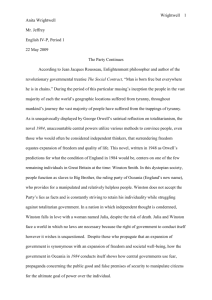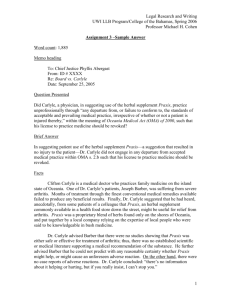GE-002-910, ART 211 GE Area C1 CALIFORNIA STATE
advertisement
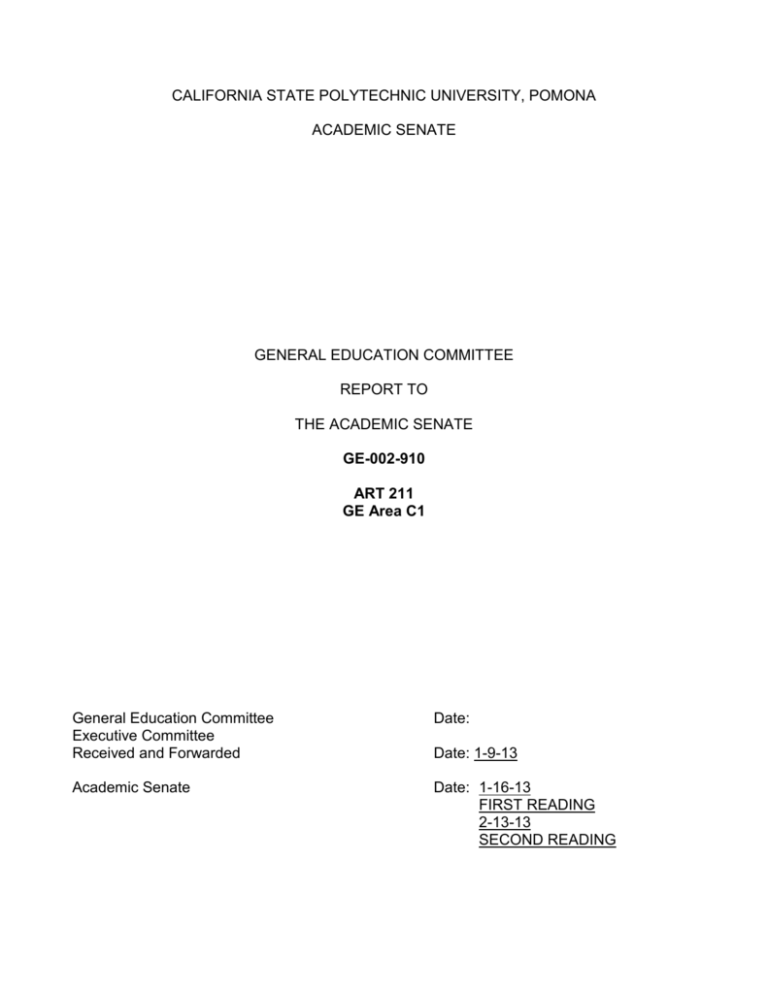
CALIFORNIA STATE POLYTECHNIC UNIVERSITY, POMONA ACADEMIC SENATE GENERAL EDUCATION COMMITTEE REPORT TO THE ACADEMIC SENATE GE-002-910 ART 211 GE Area C1 General Education Committee Executive Committee Received and Forwarded Date: Academic Senate Date: 1-16-13 FIRST READING 2-13-13 SECOND READING Date: 1-9-13 GE-002-910, ART 211 GE Area C1 2 BACKGROUND: The art history faculty proposes to add Art 211 (Arts of Africa, Oceania and Native America) to GE area C1 Humanities/Fine and Performing Arts and to add the prefix of “World Art” to the existing title of Art 211. “Arts of Africa, Oceania and Native America” will become “World Art: Arts of Africa, Oceania and Native America.” The change in title will align this proposal with GE referral GE-001-910. The course Art 211 is part of a series of 200-level introductory art history survey courses (already including Art 212, 213, 214, and 216) offered by the Art Department. However, it was unduly omitted from the current GE list of art history courses. In recent years, the department has been able to offer this course on a yearly basis, and so requests that the course have the same GE status as the other introductory art history survey courses: Art 212, 213, 214, and 216. The addition of Art 211 to the GE series is also crucial to the department’s effort to provide a more global—less Eurocentric—approach to the study of art history. RESOURCES RECOMMENDED: ART 211 ECO ART 211 justification ART 211 consultation Faculty who teach in the GE Area C1 Sarah A. Meyer, Art Department Babette R. Mayor, Art Department RESOURCES CONSULTED: ART 211 ECO ART 211 justification ART 211 consultation Faculty who teach in the GE Area C1: Dr. Alison Pearlman, Associate Professor of Art History, Art Department Dr. Chari Pradel, Associate Professor of Art History, Art Department Sarah A. Meyer, Chair, Art Department Babette R. Mayor was not consulted because she is no longer Art Department Chair, as she was when this proposal was initially developed. DISCUSSION The GE Committee agreed that the addition of this course to the series of existing GE offerings in the C1 area gives appropriate cultural breadth to the series of introductory art history survey courses (including Art 212, 213, 214, and 216) by adding another nonEuropean course. GE-002-910, ART 211 GE Area C1 RECOMMENDATION: The GE Committee unanimously recommends approval of Art 211 (Arts of Africa, Oceania and Native America) to GE area C1 Humanities/Fine and Performing Arts and to add the prefix of “World Art” to the existing title of Art 211. “Arts of Africa, Oceania and Native America” will become “World Art: Arts of Africa, Oceania and Native America. ATTACHMENTS: ART 211 ECO 3 GE-002-910, ART 211 GE Area C1 4 California State Polytechnic University Department of Art Course Title: Arts of Africa, Oceania and Native America Course Number: Art 211 Prepared by: Dr. Maren Henderson Updated by: Dr. Chari Pradel and Dr. Alison Pearlman, Fall 2012 COURSE OUTLINE I. Catalog Description Art 211 Arts of Africa, Oceania and Native America. (4). Art of the Indigenous peoples of Africa, Oceania and Native North America as understood within the context of religious beliefs and political, economic and social functions. 4 hours lecture. II. Required Background or Experience No prerequisites to date. III. Expected Outcomes Students will receive a survey of select artistic achievements from the African continent, Australia, Micro and Melanesia and Indigenous North American communities, beginning in prehistoric times where applicable but emphasizing the art of the historic period (18 th-19th centuries) and continuing into the 20th century. Upon completion of this course, students should A. Be familiar with the artistic traditions and history of the art and architecture of the selected indigenous cultures of Africa, Oceania and Native America. B. Understand the cultural achievements and historical significance of the arts in these cultures. C. Understand the worldviews and ideas expressed in the visual arts of these cultures. D. Be able to identify continuities and commonalities in the prevailing ideologies of civilizations in each region, and to recognize differences among the groups. E. Understand the structural principles, materials, and techniques that help determine objects’ forms and functions. F. Acquire the disciplinary tools of analysis for interpreting art objects within their cultural context. C. Recognize the importance of extra- and intra-cultural influences on art within various communities. H. Be able to express the above in discussion and in writing with accuracy, thoroughness, and sound reasoning. GE-002-910, ART 211 GE Area C1 5 IV. Texts and Readings Texts as required by the instructor. Examples: Caruana, Wally. Aboriginal Art. London & New York: Thames and Hudson, 2003. Penney, David W. North American Indian Art. London & New York: Thames and Hudson, 2004. Thomas, Nicholas. Oceanic Art. London & New York: Thames and Hudson, 2002. Visona, Monica, et.al. A History of Art in Africa. Prentice Hall, 2006. Additional & current periodical readings may be assigned. Examples might include the following: Ben-Amos, Paula. The Art of Benin. London: Thames & Hudson, 1998. Berlo, J The Arts of Africa, Oceania and the Americas: Selected Readings. New Jersey: Prentice Hall, 1992. Ruth B. Philips. Native North American Art. Oxford & New York: Oxford University Press, 1998. Fagg, W. et al. Yoruba Sculpture of West Africa. New York: Knopf, 1982. Feest, C.F. Native Arts of North America. New York: Thames and Hudson, 1992. Morphy, Howard. Aboriginal Art. London: Phaidon, 2001. Rubin, Arnold. Art as Technology: The Arts of Africa, Oceania, Native America and Southern California. Beverly Hills: Hillcrest Press, 1989. Wade, E.L. ed. The Arts of the North American Indian: Native Traditions in Evolution. New York: Hudson Hills, 1986. V. Minimum Student Materials Textbooks, Electronic reserve, course syllabus, and usual note-taking materials. Computer access for Blackboard, digital image database, ARTstor, research and writing assignments. VI. Minimum College Facilities Smart classroom, or a classroom with data projector, VCR and Internet access, and lighting appropriate for projection and note taking, as room 13-2218, presently used for art history classes. Seating and writing surfaces for a minimum of 50 students; instructor needs a lectern. Blackboard storage quota of no less than 150MB. VII Course Outline This survey in art history begins with the arts of Pacific cultures beginning with the ancient art of Australia and including the arts of Polynesia, Melanesia and Micronesia, as well as some GE-002-910, ART 211 GE Area C1 6 examples of contemporary work. The course continues with the early arts of Sub-Saharan Africa including Rock art, the ceramics of Nok and early metalworking of the Nri and Ife peoples; royal arts of Benin and the Asante, women’s arts in Cote d’Ivoire and Zimbabwe; divination arts among the Yoruba; and recent contemporary painting. The concluding third of the course focuses on the Indigenous arts of North America. This includes the pre-contact Southeast, historic Plains, pre-contact and historic Southwest, historic Northwest coast, and contemporary arts. The course studies a range of art and architecture produced for individual and communal use, all of which are examined for social function, style, material, craft techniques, and iconography. Special emphasis is put on the meaning of each work in its original context, with careful attention paid to social, political, religious, and contextual factors in the interpretation of meaning. Works of art studied are necessarily very selective and represent the high points in cultural achievement and historical significance. The course is intended to give the student a solid foundation in tribal arts through knowledge of these important tribes, key works and sites, and through skills in aesthetic and contextual analysis. Week 1.1, 1.2 2 3 Introduction Oceania 4 5 Africa 6 7 8 9 10 North America Subject Introduction. Ethnocentrism. Art as technology; Aboriginal Rock art Aboriginal painting; Masculine & Feminine symbolism in the Sepik River; The Asmat: cannibalism and ritual Polynesian textiles & featherwork; Maori: ancestors and lineage; Body and body ornamentation. Sub-Saharan Africa: Rock art and early sculpture; Royal arts of Benin & the Asante Women’s arts of the Kuba, Mende and Zulu; Masquerade & Divination among the Yoruba Architecture of the Djenne & Dogon; Contemporary Africa Archaic and precontact Woodlands cultures: the Moundbuilders Archaic and precontact Southwest; the historic Plains Historic Northeast Coast; Contemporary Native artists VIII. Instructional Methods A. Lecture with PowerPoint presentations and videos B. Class discussion C. In-class exams D. Online review sessions and recorded lectures are offered on Blackboard as study aids. IX. Assessment of Outcomes Three exams (90% of grade) to evaluate knowledge and comprehension of information as well as analytical skills. In every exam students are required to visually identify major works of art and architecture and must be able to answer short questions based on the reading and GE-002-910, ART 211 GE Area C1 7 lecture material. They are also required to write short essays about works that demonstrate their contextual knowledge of specific works of art shown on screen during the exam. In-class presentation of assigned weekly article, done independently or as a team (10%) X. Course Assessment To assess this course students will fill out the course evaluation forms used by Cal Poly Pomona. Ongoing feedback during the quarter will allow the instructor to make changes as necessary to meet the students’ needs. XI. Relationship of Course to Art History Program Learning Outcomes The Learning Outcomes for the course are in bolded text, and are to introduce students to the following: LO 1. Understanding of works of art and design from various historical periods and geographical areas using art historical tools of visual analysis: formal, iconographical or stylistic, as required by course content. Short exam questions allow this outcome to be evaluated. LO 2. Understanding of works of art and design in their historical and cultural contexts. Exam essays allow this outcome to be evaluated. LO 3. Skills of critical thinking through the analysis of art works or art historical writing. The in-class presentation of an assigned article allows this outcome to be evaluated. LO 4. Skills of research--general and those unique to the period, region, and/or theme of the course via appropriate use of library tools-and writing using vocabulary about art and art history. In addition, students will be exposed to LO 5. The creative process in the visual arts via the production of visual artwork LO 6. Reading and writing in French or German languages via courses in these languages LO 7. Other humanities disciplines via courses in history, foreign languages, generaleducation courses, and electives XII. Relationship of Course to GE Program Learning Outcomes According to the Curriculum Guide, courses in Area GE-C1 are supposed to "enable students to experience and appreciate the fine and performing arts in relation to the realms of GE-002-910, ART 211 GE Area C1 8 creativity, imagination, and feeling that explore the meaning of what it is to be human. Courses could include active participation in aesthetic and creative experience.” Art 211 does this by exposing students to many concrete examples of works of art and design in lectures and video materials. The Curriculum Guide also states that, after taking GE-C1 courses, “Students should understand how disciplined, individual creativity can produce objects that are obviously useful or practical but that clarify, intensify and enlarge human experience. Courses will provide a sense of the values that inform artistic expression and performance, and their interrelationships with human society." These goals are central to Art 211. This course, like all art history courses, strives to show students how artistic forms relate to their historical and cultural contexts. Item III in this ECO, entitled “Expected Outcomes,” makes the form-context connection explicit, especially in its list of the following outcomes: B. Understand the cultural achievements and historical significance of the arts in these cultures. C. Understand the different worldview and ideas expressed in the visual arts. D. Be able to identify continuities and shared ideologies that characterize common origins of civilizations of each region, and recognize aspects that differentiate the groups. C. Possess knowledge of the structural principles, materials, and techniques that help determine an object’s form and function. D. Acquire the necessary tools to interpret art within cultural context and to recognize the importance of extra- and intra-cultural influence within these communities.


